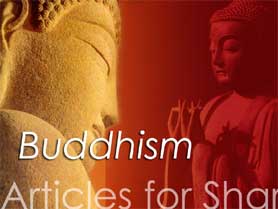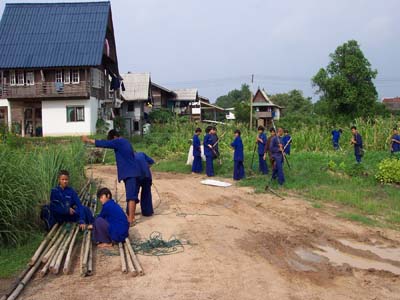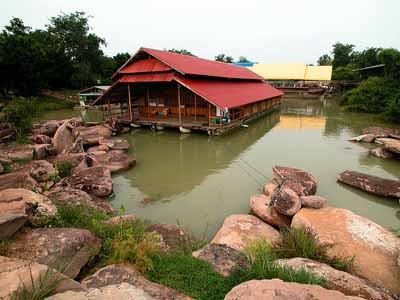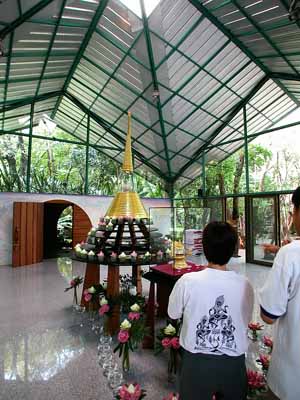
| Buddhism in General
|
||||||||||||||
 |
||||||||||||||
| Asoke Trip |
||||||||||||||
The bus was equipped with comfortable seats and food was provided during the journey. By the time we arrived at our destination, it was only 4.30am . A devotee of Ven. Jin Xiang came to fetch us. He was a policeman, but after he joined the Asoke community, he began to observe the five precepts and became a vegetarian. He then opened a small shop for his wife to sell the organic products of Asoke village and after a few years, his shop became the biggest in the town. His house was also very beautiful for their standard of living. He was a very devoted member of the Asoke community, holding strong to his five precepts, and serving the community as a policeman. He told us frankly that he was also facing a lot of difficulties in the police academy with his strong adherence to the precepts, and being a vegetarian. However, he was very proud and happy to be a real Buddhist practitioner. He also shared with us a good family practice, which I think was what made his family life blissful. He was staying with his wife who was pregnant. They were already blessed with a son who was attending school in Sisa-Asoke (and staying there). His parent-in-laws, who were both Asoke followers, and his own mother were staying with him. Everyday they would sit down together for dinner and after dinner, they would share with each other their experiences of the day and the problems they faced in practicing the Dharma during the day. Then the others will give their opinions and encouraged each other to improve on the Buddha's path. This is what we could really call a Buddhist family. They really put practicing of the Dharma in the family. Instead of sitting down to meditate, which is an individual cultivation, sitting down in a family circle to review the daily life, the extent of each family member's cultivation, and be each others' Kalyana Mitra, encourages everyone to develop further, together. In the Asoke community, they have their own standard of checking their own progress. They believe that everyone can be an Arahant, and if you could uphold the five precepts to the fullest, you are already an Arahant on the first stage (cu guo). This is followed by fully observing the eight precepts (which many of the villagers were doing) leading to the 2nd stage of Arahantship (er guo), and the upholding of the ten precepts leading to the third stage (san guo). For those who become a Bhikku or Bhikkuni and upkeep the precepts to the fullest, they could be an Arahant. The important thing is to keep the precepts and cut down the desires step by step, till there is no desire, leading to the attainment of Nirvana.
That day we also visited the Asoke Museum in the Sisa Asoke village. It was set up by Ven. Jin Xiang. Fu Bao had also published about it in the latest issue. We managed to visit a few organic "food and vegetarian orchards". They were like the jungle, covered with weed. The fruits were so tasty though and you could just pluck any of the vegetables to put in your mouth without worrying about toxins from pesticides. We ate lots of rambutan that evening. That night we were treated to the local Thai vegetarian Tom Yam and other local food by the policeman family. The next morning, we went to visit one of the ancient cities (something like Angkor Wat, but in a much smaller scale) in the Thai-Cambodia border. The place originally belonged to Thailand , but the French took possession of it when they ruled Cambodia . The border people could cross the border by paying 50 baht, so we pretended to be Thais in order to cross over. One of the Cambodian officers came to us and asked us some questions in Thai. We couldn't understand him. Luckily Bro. Maha came to our rescue.
After that, we went to visit Ajahn Chah's place, which was a local as well as an international cultivation forest. High walls surrounded the temples and the public could only access a certain area. This kept the cultivation places secluded for the monks and practicing lay people. However, we were allowed to tour the whole place. Ven. Jin Xiang shared with us a lot on the development and current situation of Thai Buddhism. I learned a lot from this. Then we went to another Asoke village - Ratchatani Asoke. This is the village that would be flooded for at least one to four months every year. They maintained a lot of big boats in preparation for the flood. There, we saw the biggest building among the Santi Asoke community. This place would be developed into the administrative centre of Asoke in the near future, hence the big building. Imagine the wisdom of Ven. Bodhirak. He would change the most difficult place into a place where everyone wanted to be. One of the villagers told us that it was a good place and they would get a new house every year due to the flood! Every time when it flooded, the other villages would send food and other stuff for the villagers, and have a celebration of sorts with games, performances, etc.
If you would like to share your own experiences in Buddhism, please feel free to email the editor at rykong@thanhsiang.org.
|
||||||||||||||
|
||||||||||||||
| Thank
you for reading the Than Hsiang E-zine. Unsubscribe I Subscribe I Change subscription |
||||||||||||||



